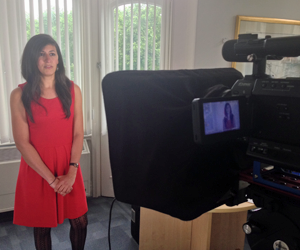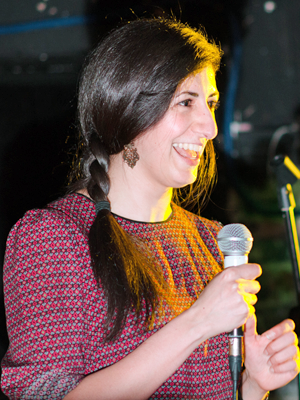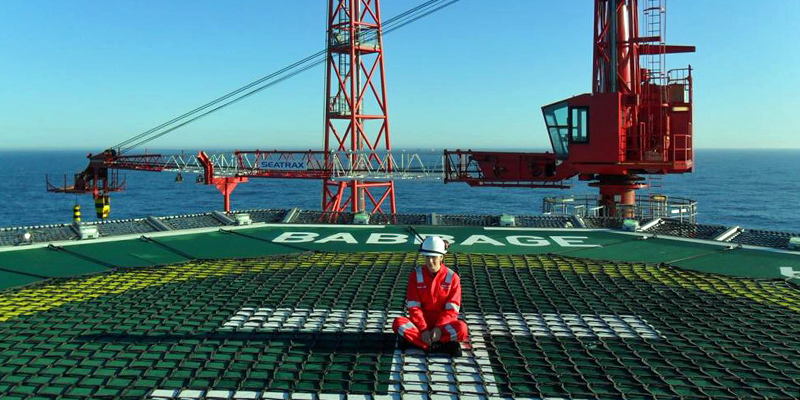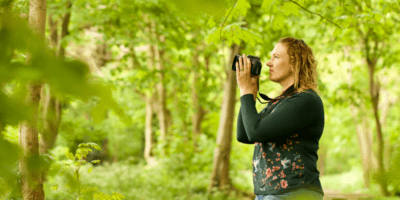Yasmin Ali is an energy innovation programme manager for the Government’s Department for Business, Energy and Industrial Strategy (BEIS). At the moment, Yasmin is working with a new £1 billion tranche of funding for the Net Zero Innovation Portfolio. She is also currently in the process writing a book about energy for a non-technical audience.

“I have seen the insides of a coal fired power station with hills of the black fuel piled outside, flown out on helicopters to visit oil and gas platforms and rigs in the middle of the North Sea, and I now work with some of the UK’s top innovators to decarbonise the country.”
From meeting the Queen to making liquid nitrogen ice cream
My career in the energy sector has taken me to some unique and wonderful places and allowed me to learn from amazing experts. I have seen the insides of a coal-fired power station with hills of the black fuel piled outside, flown out on helicopters to visit oil and gas platforms and rigs in the middle of the North Sea, and I now work with some of the UK’s top innovators to decarbonise the country.
Alongside this, I have spoken to a huge number of students and members of the public about the joy and importance of engineering and the energy sector, written extensively about this subject, been on television documentaries as an engineering expert, and even met the Queen!
My degree in chemical engineering from the University of Nottingham and a three-month summer placement at a gas-fired power station kickstarted my interest and career in energy. After graduating, I joined a graduate scheme with E.ON, starting out at Ratcliffe-on-Soar coal-fired power station.

I liked working on electricity generation, there is something quite satisfying about being involved in a product like electricity that everyone relies on. I wanted to know everything about it – including how we get the fuels for generating electricity out of the ground, which motivated me to join E.ON’s oil and gas exploration and production business.
After about five years there, I moved on to work on district heating networks and managed the control room of a small power station in the heart of London. Seven years into my career in energy, I felt like I had seen many of the jigsaw pieces of the energy puzzle but didn’t know what the full picture on the cover of the box looked like. I decided to leave and look for a role that gave me a broader view of the energy system.
After speaking to lots of people and drawing on the wisdom of those further into their career than myself, I landed at the UK Government’s Department for Business, Energy and Industrial Strategy (BEIS). For the past three years or so, I have been running energy innovation programmes, with the overall goal of reaching net zero emissions by 2050.
Throughout my career, I have dedicated time to promoting engineering. I got into the profession by chance, after getting a blue and orange ‘whynotchemeng’ leaflet in the post; a campaign run by the Institution of Chemical Engineers. If it wasn’t for that leaflet, I would not be where I am today, so I want to spread the word and give others the knowledge to make informed career choices.
Over the years, I have spoken at schools and public events: one of my favourites was making liquid nitrogen ice cream at the Science Museum and telling visitors about the science behind this.
Encouraging the switch to low carbon
My day-to-day role at the Department for Business, Energy and Industrial Strategy involves a mixture of people and project management, communication with different teams and external people, and advising policy teams.
I recently started one of my days with giving a talk for Australian government officials and innovators about the UK’s industrial decarbonisation landscape, then jumped back into work on the Industrial Fuel Switching innovation competition.
I have spent the last few months speaking to academia, industry and policy colleagues to assess what sort of technical solutions are needed to enable industry to switch from high to low carbon fuels and worked with my team to design an innovation competition to meet the needs. Launching the competition, receiving and assessing bids for funding, awarding contracts, and managing the winning projects follow on from this.
Within all of that, a lot of interaction takes place with finance and commercial professionals, co-ordinating announcements with the communications team, and visiting sites of projects. I have visited cement, glass, and brick manufacturing sites – as an engineer, I find these visits fascinating!
I manage several competitions like the Industrial Fuel Switching one and provide engineering and technical advice to policy teams. All the above keeps me busy and challenged!
Energy innovation
My work falls under two major innovation programmes that aim to reduce carbon emissions. One of these was the Energy Innovation Programme, a £505 million programme that ran between 2015 and 2021. The funding was divided across many areas of the energy sector, and the aim was to develop technical solutions to reduce emissions.
I worked on programmes under the ‘industry’ theme, which included developing energy efficiency technology for industry through the Industrial Energy Efficiency Accelerator, and funding for low carbon hydrogen supply solutions.
I saw some very creative projects coming through – such as ‘Dolphyn’, a floating offshore wind turbine, with integrated hydrogen production by electrolysis on the base of the wind turbine. Instead of sending electricity back to shore through a cable, the structure uses the electricity generated to make hydrogen from water by electrolysis, and pipe this back to shore.
Government funding should help organisations to develop innovation that they otherwise would not have the resources to do, so the programme will hopefully help the UK with its journey to net zero emissions by 2050. From 2021 to 2025, we are now working with a new tranche of funding of £1 billion for the Net Zero Innovation Portfolio.
Adjusting to a new world
COVID-19 has completely changed my working environment. I have gone from being in an office close to the heart of government in Westminster, surrounded by my colleagues, to working from the dining table with my partner working at the other end. It took me a while to adjust, but I am used to this new world. It was difficult to get out on-site visits too, but this is starting to pick back up now.
Overall, I think working from home has allowed me to focus more on my own work but has deprived me of wider interactions and the informal learning that happens when I am around others.

The other big adjustment was, initially, a lack of public engagement activities, which eventually re-surfaced in an online format. I have continued to give talks online, and I am very happy to be returning to some in-person events now.
Bringing out the human side of energy and engineering
Diversity and inclusion are extremely important for innovation in my opinion; diversity of thought is a catalyst for creativity and a diverse group of people is much more likely to come up with inclusive ideas by drawing on their own different backgrounds and experiences. This is especially important for energy and sustainability because it is an issue that touches everyone, so it makes sense to involve a representative group of people to develop solutions.
There is a challenge in engaging a diverse range of people in energy, and in particular engineering. I think communicating engineering and energy in a less technical way and bringing out the human side that exists under the surface can go a long way to attract more people into the sector. Over the last ten years, I have spent a lot of time speaking to young people and members of the public about the sector, and I encourage others to do the same.
Making a positive influence on our energy future
We are in the midst of an energy transition – it is a very exciting time to be in this sector. It is an opportunity to look back at how far we have come in terms of global energy access, but also reflect on what could have been done better and how to avoid making the mistakes of the past again.
One of the things I have loved about my career so far is ending up in unexpected places, so I am excited to see what the future brings. I am also determined to make a positive influence on our energy future.
Outside of my job at BEIS, I am in the middle of something else – writing a book about energy, commissioned by the publisher Hodder & Stoughton and due to come out in 2024. The book is intended for a non-technical audience, to explain our energy systems and highlight the people who work in the sector. So far, I have really enjoyed the writing process and had some fascinating chats with people in energy all over the world, so I am looking forward to sharing these experiences with everyone!
Reference links
- https://www.linkedin.com/in/yasmin-ali-a9655426/
- http://www.engineeryasmin.com/
- https://twitter.com/EngineerYasmin
- https://www.gov.uk/government/organisations/department-for-business-energy-and-industrial-strategy
- https://www.linkedin.com/company/beisgovuk/
- https://www.gov.uk/government/collections/net-zero-innovation-portfolio





